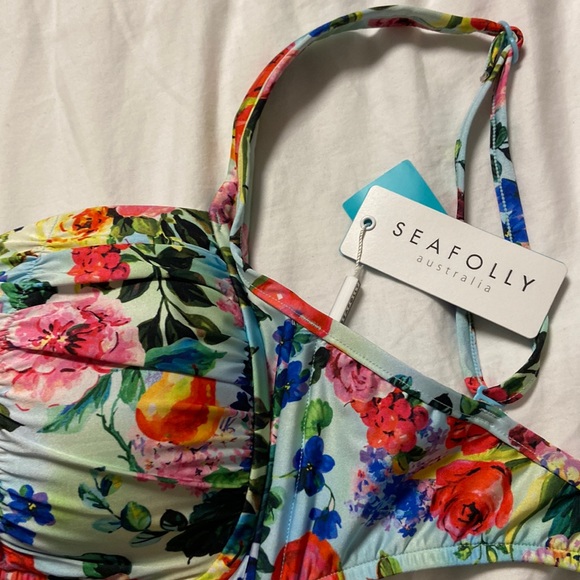Content Menu
● The Evolution of Seafolly
● Ownership Changes
● The Impact of Ownership on Brand Strategy
● Seafolly's Commitment to Sustainability
● The Future of Seafolly
● The Role of Marketing in Seafolly's Success
● The Importance of Customer Engagement
● Seafolly's Global Reach
● Challenges in the Swimwear Industry
● The Role of Technology in Seafolly's Growth
● Conclusion
● Frequently Asked Questions
>> 1. Who currently owns Seafolly?
>> 2. What types of products does Seafolly offer?
>> 3. Is Seafolly committed to sustainability?
>> 4. How has Seafolly expanded its market presence?
>> 5. What is the brand's design philosophy?
Seafolly is a prominent Australian swimwear brand that has made a significant mark in the fashion industry, particularly known for its vibrant designs and high-quality materials. Founded in 1983, Seafolly has become synonymous with beach culture and summer fun, offering a wide range of swimwear, beachwear, and accessories. Over the years, the brand has undergone various changes in ownership, reflecting the dynamic nature of the fashion industry and the evolving market demands.

The Evolution of Seafolly
Seafolly began its journey in the early 1980s, founded by a group of passionate individuals who aimed to create stylish and functional swimwear. The brand quickly gained popularity, thanks to its innovative designs and commitment to quality. Seafolly's collections often feature bold colors, unique patterns, and flattering cuts, appealing to a diverse customer base.
As the brand grew, it expanded its product offerings to include not only swimwear but also beach cover-ups, activewear, and accessories. This diversification helped Seafolly establish itself as a lifestyle brand, catering to customers looking for fashionable options for their beach outings.
Ownership Changes
In the early 2000s, Seafolly was acquired by the private equity firm L Catterton, which recognized the brand's potential for growth in both domestic and international markets. Under L Catterton's ownership, Seafolly experienced significant expansion, opening new stores and increasing its presence in key markets, including the United States and Asia.
However, in recent years, the brand faced challenges due to changing consumer preferences and increased competition in the swimwear market. As a result, L Catterton decided to sell Seafolly to a strategic buyer in Asia for approximately $70 million. This sale marked a new chapter for the brand, as it sought to leverage its new ownership to explore fresh opportunities and expand its reach.

The Impact of Ownership on Brand Strategy
Ownership changes can significantly impact a brand's strategy and direction. With the new Asian ownership, Seafolly is expected to focus on enhancing its online presence and tapping into the growing demand for swimwear in Asian markets. The brand aims to leverage its heritage and reputation while adapting to the preferences of a new customer base.
The new ownership is likely to bring in fresh ideas and innovative marketing strategies, allowing Seafolly to remain competitive in the ever-evolving fashion landscape. By embracing digital transformation and enhancing its e-commerce capabilities, Seafolly can reach a broader audience and cater to the changing shopping habits of consumers.
Seafolly's Commitment to Sustainability
In addition to its focus on growth and expansion, Seafolly is also committed to sustainability. The brand recognizes the importance of environmental responsibility and has taken steps to reduce its ecological footprint. This includes using sustainable materials in its swimwear collections and implementing eco-friendly practices in its production processes.
Seafolly's commitment to sustainability resonates with consumers who are increasingly conscious of their purchasing decisions. By aligning its brand values with those of its customers, Seafolly can strengthen its position in the market and foster brand loyalty.

The Future of Seafolly
As Seafolly embarks on this new journey under Asian ownership, the brand is poised for exciting developments. With a renewed focus on innovation, sustainability, and customer engagement, Seafolly aims to solidify its status as a leading swimwear brand globally.
The brand's future strategies may include collaborations with influencers and designers, limited-edition collections, and enhanced customer experiences both online and in-store. By staying attuned to market trends and consumer preferences, Seafolly can continue to thrive in the competitive swimwear industry.
The Role of Marketing in Seafolly's Success
Marketing plays a crucial role in the success of any brand, and Seafolly is no exception. The brand has employed various marketing strategies to connect with its target audience and build a strong brand identity. Social media has been a significant platform for Seafolly, allowing the brand to showcase its products, engage with customers, and promote its lifestyle image.
Influencer partnerships have also been a key component of Seafolly's marketing strategy. By collaborating with popular influencers and fashion bloggers, Seafolly has been able to reach a wider audience and create buzz around its collections. These partnerships not only enhance brand visibility but also lend credibility to the brand, as influencers often share their personal experiences with Seafolly products.
The Importance of Customer Engagement
In today's competitive market, customer engagement is more important than ever. Seafolly has recognized this and has implemented various initiatives to foster a strong relationship with its customers. This includes personalized marketing campaigns, loyalty programs, and interactive social media content.
By actively engaging with customers, Seafolly can gather valuable feedback and insights, allowing the brand to adapt its offerings to better meet customer needs. This customer-centric approach not only enhances brand loyalty but also drives sales and growth.

Seafolly's Global Reach
Seafolly's expansion into international markets has been a significant focus for the brand. With the rise of e-commerce, Seafolly has been able to reach customers beyond Australia, tapping into markets in the United States, Europe, and Asia. The brand's online store offers a seamless shopping experience, allowing customers to browse and purchase products from anywhere in the world.
In addition to its online presence, Seafolly has also opened physical stores in key international locations. These flagship stores serve as a representation of the brand's identity and provide customers with an immersive shopping experience. The combination of online and offline strategies has allowed Seafolly to establish a strong global presence.
Challenges in the Swimwear Industry
The swimwear industry is not without its challenges. Increased competition, changing consumer preferences, and economic fluctuations can impact sales and brand performance. Seafolly has faced these challenges head-on by continuously innovating and adapting its strategies.
The rise of fast fashion has also posed a threat to established swimwear brands like Seafolly. Consumers are increasingly drawn to affordable and trendy options, which can make it difficult for premium brands to maintain their market share. To combat this, Seafolly has focused on emphasizing its quality, craftsmanship, and unique designs, setting itself apart from fast fashion competitors.
The Role of Technology in Seafolly's Growth
Technology has played a pivotal role in Seafolly's growth and success. The brand has embraced digital transformation, utilizing advanced analytics and data-driven insights to inform its marketing strategies and product development. By understanding customer behavior and preferences, Seafolly can create targeted campaigns that resonate with its audience.
E-commerce technology has also enabled Seafolly to streamline its online shopping experience. Features such as virtual fitting rooms, personalized recommendations, and easy checkout processes enhance customer satisfaction and drive sales. As technology continues to evolve, Seafolly is likely to explore new innovations to further enhance its customer experience.

Conclusion
Seafolly's journey from its inception to its current ownership reflects the brand's resilience and adaptability in a competitive market. With a new strategic direction and a commitment to sustainability, Seafolly is well-positioned to navigate the challenges of the fashion industry and continue to delight customers with its stylish swimwear collections.
As the brand evolves, it will be interesting to see how it leverages its heritage while embracing innovation to meet the demands of modern consumers. The future looks bright for Seafolly, and its loyal customer base can expect exciting developments in the years to come.
Frequently Asked Questions
1. Who currently owns Seafolly?
Seafolly is currently owned by an Asian strategic buyer, following its sale by L Catterton.
2. What types of products does Seafolly offer?
Seafolly offers a wide range of swimwear, beachwear, activewear, and accessories.
3. Is Seafolly committed to sustainability?
Yes, Seafolly is committed to sustainability and has implemented eco-friendly practices in its production processes.
4. How has Seafolly expanded its market presence?
Seafolly has expanded its market presence by opening new stores and enhancing its online presence, particularly in international markets.
5. What is the brand's design philosophy?
Seafolly's design philosophy focuses on creating stylish, functional, and high-quality swimwear that appeals to a diverse customer base.




































































